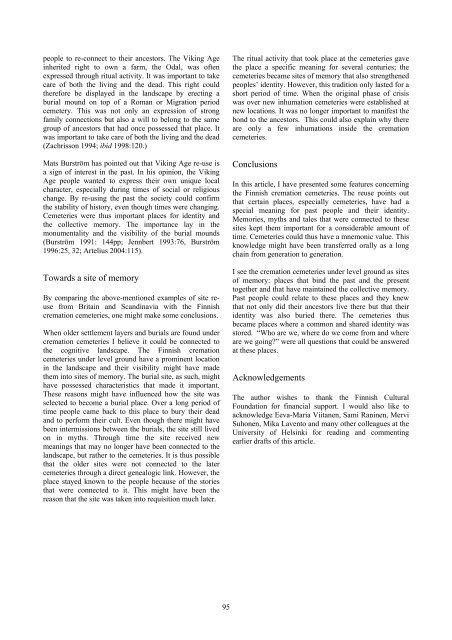The Materiality of Death - mikroarkeologi.se
The Materiality of Death - mikroarkeologi.se
The Materiality of Death - mikroarkeologi.se
Create successful ePaper yourself
Turn your PDF publications into a flip-book with our unique Google optimized e-Paper software.
people to re-connect to their ancestors. <strong>The</strong> Viking Age<br />
inherited right to own a farm, the Odal, was <strong>of</strong>ten<br />
expres<strong>se</strong>d through ritual activity. It was important to take<br />
care <strong>of</strong> both the living and the dead. This right could<br />
therefore be displayed in the landscape by erecting a<br />
burial mound on top <strong>of</strong> a Roman or Migration period<br />
cemetery. This was not only an expression <strong>of</strong> strong<br />
family connections but also a will to belong to the same<br />
group <strong>of</strong> ancestors that had once pos<strong>se</strong>s<strong>se</strong>d that place. It<br />
was important to take care <strong>of</strong> both the living and the dead<br />
(Zachrisson 1994; ibid 1998:120.)<br />
Mats Burström has pointed out that Viking Age re-u<strong>se</strong> is<br />
a sign <strong>of</strong> interest in the past. In his opinion, the Viking<br />
Age people wanted to express their own unique local<br />
character, especially during times <strong>of</strong> social or religious<br />
change. By re-using the past the society could confirm<br />
the stability <strong>of</strong> history, even though times were changing.<br />
Cemeteries were thus important places for identity and<br />
the collective memory. <strong>The</strong> importance lay in the<br />
monumentality and the visibility <strong>of</strong> the burial mounds<br />
(Burström 1991: 144pp; Jennbert 1993:76, Burström<br />
1996:25, 32; Artelius 2004:115).<br />
Towards a site <strong>of</strong> memory<br />
By comparing the above-mentioned examples <strong>of</strong> site reu<strong>se</strong><br />
from Britain and Scandinavia with the Finnish<br />
cremation cemeteries, one might make some conclusions.<br />
When older <strong>se</strong>ttlement layers and burials are found under<br />
cremation cemeteries I believe it could be connected to<br />
the cognitive landscape. <strong>The</strong> Finnish cremation<br />
cemeteries under level ground have a prominent location<br />
in the landscape and their visibility might have made<br />
them into sites <strong>of</strong> memory. <strong>The</strong> burial site, as such, might<br />
have pos<strong>se</strong>s<strong>se</strong>d characteristics that made it important.<br />
<strong>The</strong><strong>se</strong> reasons might have influenced how the site was<br />
<strong>se</strong>lected to become a burial place. Over a long period <strong>of</strong><br />
time people came back to this place to bury their dead<br />
and to perform their cult. Even though there might have<br />
been intermissions between the burials, the site still lived<br />
on in myths. Through time the site received new<br />
meanings that may no longer have been connected to the<br />
landscape, but rather to the cemeteries. It is thus possible<br />
that the older sites were not connected to the later<br />
cemeteries through a direct genealogic link. However, the<br />
place stayed known to the people becau<strong>se</strong> <strong>of</strong> the stories<br />
that were connected to it. This might have been the<br />
reason that the site was taken into requisition much later.<br />
<strong>The</strong> ritual activity that took place at the cemeteries gave<br />
the place a specific meaning for <strong>se</strong>veral centuries; the<br />
cemeteries became sites <strong>of</strong> memory that also strengthened<br />
peoples’ identity. However, this tradition only lasted for a<br />
short period <strong>of</strong> time. When the original pha<strong>se</strong> <strong>of</strong> crisis<br />
was over new inhumation cemeteries were established at<br />
new locations. It was no longer important to manifest the<br />
bond to the ancestors. This could also explain why there<br />
are only a few inhumations inside the cremation<br />
cemeteries.<br />
Conclusions<br />
In this article, I have pre<strong>se</strong>nted some features concerning<br />
the Finnish cremation cemeteries. <strong>The</strong> reu<strong>se</strong> points out<br />
that certain places, especially cemeteries, have had a<br />
special meaning for past people and their identity.<br />
Memories, myths and tales that were connected to the<strong>se</strong><br />
sites kept them important for a considerable amount <strong>of</strong><br />
time. Cemeteries could thus have a mnemonic value. This<br />
knowledge might have been transferred orally as a long<br />
chain from generation to generation.<br />
I <strong>se</strong>e the cremation cemeteries under level ground as sites<br />
<strong>of</strong> memory: places that bind the past and the pre<strong>se</strong>nt<br />
together and that have maintained the collective memory.<br />
Past people could relate to the<strong>se</strong> places and they knew<br />
that not only did their ancestors live there but that their<br />
identity was also buried there. <strong>The</strong> cemeteries thus<br />
became places where a common and shared identity was<br />
stored. “Who are we, where do we come from and where<br />
are we going?” were all questions that could be answered<br />
at the<strong>se</strong> places.<br />
Acknowledgements<br />
<strong>The</strong> author wishes to thank the Finnish Cultural<br />
Foundation for financial support. I would also like to<br />
acknowledge Eeva-Maria Viitanen, Sami Raninen, Mervi<br />
Suhonen, Mika Lavento and many other colleagues at the<br />
University <strong>of</strong> Helsinki for reading and commenting<br />
earlier drafts <strong>of</strong> this article.<br />
95
















